By Girija Madhavan
Our lessons began on Valmiki Road, shaded by rain trees, where traffic was sparse. We would drive slowly up to the Mosque at the end of the road, turn round and drive back. Father insisted that I practise hand signals as I drove. At that time the fashion was to wear glass bangles; my signalling became a glittering, tinkling affair. So father banned the bangles.
Saudi Arabia was recently reported to have permitted the women of the country to drive cars. An Arab woman, burqa-clad, eyes covered by dark glasses, was shown on TV driving while other motorists gave her a “Thumbs Up” salutation to her new-found liberty. Some reports say it may take a while to implement the rule.
I remember learning to drive in Mysore in 1955. My father, M. Venkatesh, had sold his vintage Standard car with the “Stepney” tyre mounted on the back for Rs.1,000 and had bought a 1950’s Morris Minor in green for Rs.5,000. He refused my request to teach me driving as I was only 17-years-old. My mother Mukta argued that in our custom, I was considered to be in my eighteenth year after turning seventeen. So he gave in.
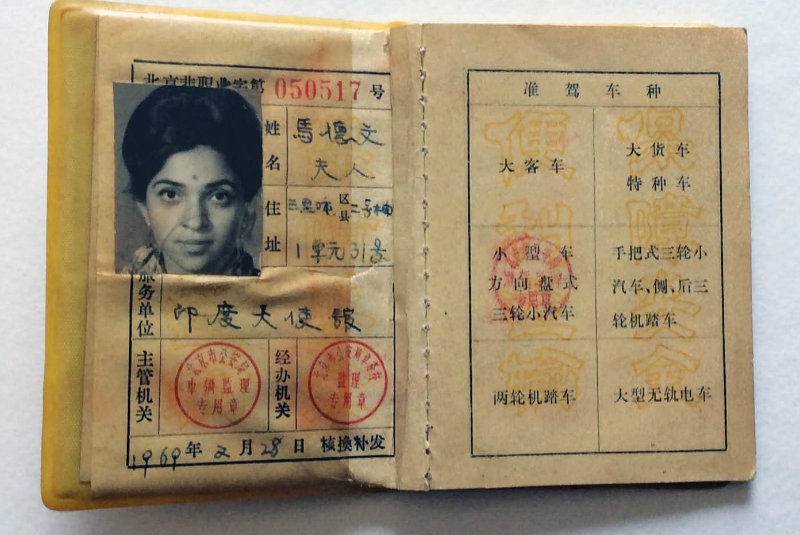
Girija’s Chinese driving licence of 1969.
Our lessons began on Valmiki Road, shaded by rain trees, where traffic was sparse. We would drive slowly up to the Mosque with the tiled outhouse at the end of the road, turn round and drive back. Father insisted that I practise hand signals as I drove. A right turn was denoted by extending the arm out of the window and pointing right. The left was more difficult, the hand making semi-circular movements towards the left. An onward wave indicated that the car behind could overtake. A quick up-and-down sign of the extended arm meant slowing down, the arm held up, palm upstretched, indicated “Stop.” At that time in Mysore the fashion was to wear many glass bangles; my signalling became a glittering, tinkling affair. So father banned the bangles.
Once a flock of goats crossed the road. Instead of the brake I pressed the accelerator, the bleating goats scattering before us. Father, shooing away the animals with his right hand and pressing an imaginary brake-pedal with his foot, shouted “Brake! Brake!” No goats were hurt and we drove away as the goat-herd finally appeared, shaking his stick at us.
Our practice moved to Princess Road. From Cheluvamba Park, we drove past Akashavani to the Jewel Filters [now called Vani Vilas Water works]. The return journey took us past the old statue of the Elephant at the head of Cheluvamba Park and the Vivekananda Memorial. It is still there, unchanged. One day, at that point, a Royal Enfield motorcycle, known as “Bullet,” drew up alongside, the khaki- clad rider flagging us down. It was Sergeant Kuttappa, an upright, strict Police Officer, respected and feared in Mysore. He advised my father to get me a Learner’s licence so that I did not drive without authorisation. Chastened, my father agreed. Later on, when we sometimes passed him on the road, he would give us a half smile. These driving lessons came in handy the next year when my father suffered a heart attack and I was able to drive him to the hospital for treatment.
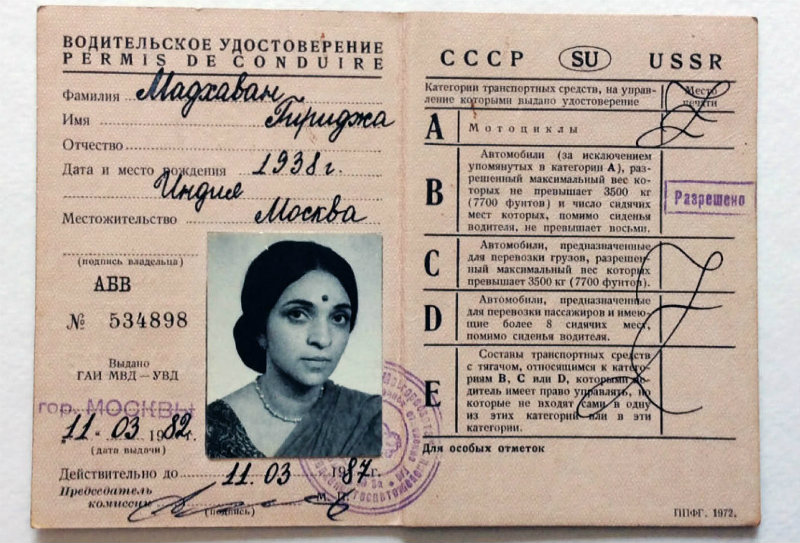
Girija’s licence of 1982 issued in Moscow.
I took my hard-won Indian licence with me when my husband A. Madhavan was posted to Indian Embassies abroad, using it as ID to obtain local ones. In 1968, we went to Beijing [called Peking then] in the Peoples’ Republic of China. The country was in the throes of Chairman Mao’s Great Proletarian Cultural Revolution. Sino-Indian relations were tense and Indian diplomats had been man-handled, the Embassy besieged. By an oversight, I had allowed my Indian licence to lapse earlier. The Chinese authorities insisted I should take their driving test to get a Chinese licence.
I reported to the Traffic Police the next day in our personal car and was taken to an open clearing where, on the mud, two abutting rectangles were marked in chalk, each a few feet bigger than the car. The test was to shift the car from one oblong to the next in four moves without crossing the outer borders. This was the test that taxi drivers in Beijing had to take! I failed the test.
However, a search of our papers turned up a Swiss licence from an earlier post which still was valid. It was reluctantly accepted and I got my Chinese licence. Roads in Beijing then were dominated by bicycles, riders wearing blue boiler suits as well as a few official cars, taxis, pedicabs and horse-drawn carts with a little donkey alongside. Any accident involving foreigners invited the wrath of the Red Guards [revolutionary youth] who would “struggle against” erring drivers.
A car ride I remember to this day was in Moscow in November 1982. Solemn music on the radio gave a hint of the death of the Soviet leader, Leonid Brezhnev. Among the dignitaries at the Kremlin funeral was Prime Minister Indira Gandhi. The staff car sent for my husband to go to Sheremetyevo Airport broke down. So we had to go there in our own small car. At the airport, flashing lights on the tarmac showed that the Indian Prime Minister was being ushered into a Zil limousine directly from the aircraft and a line of cars was already setting off. Our diplomatic number plate permitted us to join the convoy. Headed by escort Police, the black limousines headed for the Dacha [guest house] where she was to stay. We tailed them in our dusty car, finding the rapid pace hard to maintain. Later I was told that someone appealed to a Russian driver to slacken speed to let me to keep pace. The answer was a curt “Nyet! If she joins a convoy she has to keep pace!” We made it and Madhavan was on time to be in the receiving line. He even saw Fidel Castro, also a guest at the Dacha!
Now my daily challenge is to negotiate the octopus circle at Cheluvamba Park where seven roads criss-cross; almost as difficult as the driving test in Beijing! The traffic lights stay switched off. There is no “Right of way,” might is right, the more daring drivers get across. I feel unnerved when vehicles behind me keep honking, urging me to move forward just as buses pass in front; or when someone cuts across our car from the left to go right. My hand signals now are changing: I point to the traffic streaming ahead and mime my inability to proceed. I hope I do not end up shaking my fist as a new signal !




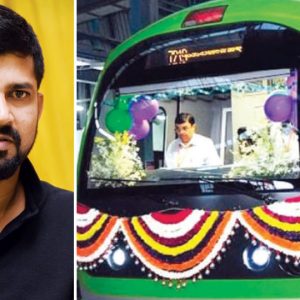
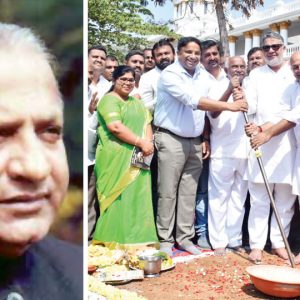
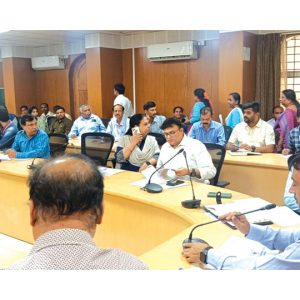
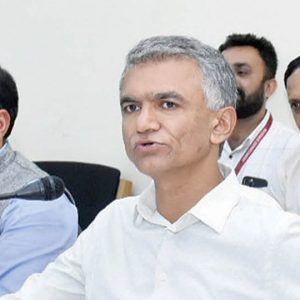
Very well written, The sight of old Mysore flew in my mind while I read the article.
Well I had almost forgotten the elephant statue in front of cheluvamba park road, which my mother showed it to me whenever we passed tha road.
Thank you for bringing back wonderful memories of old Mysore.
In those days, there was no necessity to own a car and learn driving. We could walk end to end or at the worst take the bicycle. No traffic and no pollution. Chest infections unlike now were unheard of. This author should have written about how wonderful the walking was in those days within the very compact Mysore boundaries.
Beautifully captured moments of Mysore soil extended to world wide destinations and back. I could imagine and visualize besides feel each road explained and remember the good old cars that roamed at the princely city of Mysore. I had witnessed the same while in China exactly the way explained. I spent most years in Mysore being a local Mysorean and days are not same anymore when I visited the city few weeks back. There was Standard Super10,Morris Minor and Morris Major which resembled counterparts of VW Beetle. The city was cool and vibrant then to see few vehicles roaming only from elites. I could add the joy of walking at “Thandi Sadak” only for humans which is now a part of Zoo! We have devolved not evolved. Time matter and memories last but its people who matter then and now. No wonder what is to be seen next?
Yadavagiri Ectension & Vivekanada Road then was like an Mud Road with few houses as allotted by the City improvement Board.?
To some Doctors & Engineers of the Ranked Officials ,Administaatrs of the then Government !! Starting with Dr.H.V.Ramaswamy the personal doctor of His Highness the Maharaja of Mysore & the Game officer D.N Neelakanta Rao also to the Royal family were living among others ?
ONLY EIGHT HOUSE EXISTED THEN? The rest of the area were Dry land cultivated.? Traffic was almost nil.!!
Sri M.Venkatesh of highly qualified : cultured of high Rank ,Status soft Spoken beyond discriptions of hmanity & Authority of the Railways were the proud Residents with his family ? The only family who were of Highly Educated in those early years a task of up hill!! Arduous agony to come up with the Best Education of World Standard Education was Hard..!! I highly Admire Mrs. Girija Madhavan as the foremost resident with utmost Education Culture, most sports & activity world Renown second to None!! Pride of humanity of our Country!! we see very hand full of such greats among !! Jai Karnataka.!! Jai Hind.
Mysuru then and now? Them we could enjoy walking any time of the day, during lunch hour for example, and the exercise did us a world of good. There were proper footpaths, road vehicle count was minimal and the if one wanted pure air , one cold take a walk just outside the extensions. Plenty of water coming out of taps,
Now, not sure about today, but when we visited some 20 years ago, my relatives were suffering from acute water shortage, vegetable bill was rocketing into hundreds of rupees, worried about their kids coming home safe from schools, not meeting marauding cars trying to run them over as footpaths and roads joined seamlessly together.
We did not think then that beautiful Mysuru will go the same way as Bengaluru, but we were very wrong then. Mysoru inhabitants will regret the way the direction that the city has taken. At a time when pedestrians are increasingly get their freedom to walk and bicycles are finding their way into Western cities, Mysuru has firmly grasped the car culture.
In the early 1960s, while Bangalore had several auto rickshaws, Mysore had only 3 autos plying on the road and I still remember the registration no. of one them , MYA 253.
Otherwise, Mysore had horse ridden tongas or Jatakaas as they are popularly called.
My father had a rickety old Moris Minor car, and he would often park the car at the top of sloping road, to enable us push the car for it had starting problem and would be on the move ,courtesy push-start.
The car also had an opening aperture in lower posrtion of bonnet for crank starting, a steel rod with a handle to give a brisk rotation for the engine to start when car battery failed for self-start.
Morris Minor was an English car, shipped to India after several owners in England used the car for thousands of miles!! That is the truth!!
During 60’s in Mysore, in the Saraswathipuram I main road, as a primary school going child, only car ever I saw was Famous Kannada film producer Director Shankar Singh and Prathima Devi’s Black Hillman parked in front of their house. I used to go to Sharada Shishuvihara around that corner of I main Road. It is a great and very vivid memory of very few cars running on broad, beautiful and clean roads of Mysore city. It was a peaceful time. Champak, Jasmine and Parijataha Trees in the front gardens of most houses. Their fragrance in the evenings is another great memory I have from my school days. It remained that way even during early 80’s. But during 90’s everything changed. IT sector manapoly and population explosion changed our city and lives of millions for good and off course for worse! Only my memories can bring those pictures and some articles like this keep the picture of that Mysore alive. Great article.